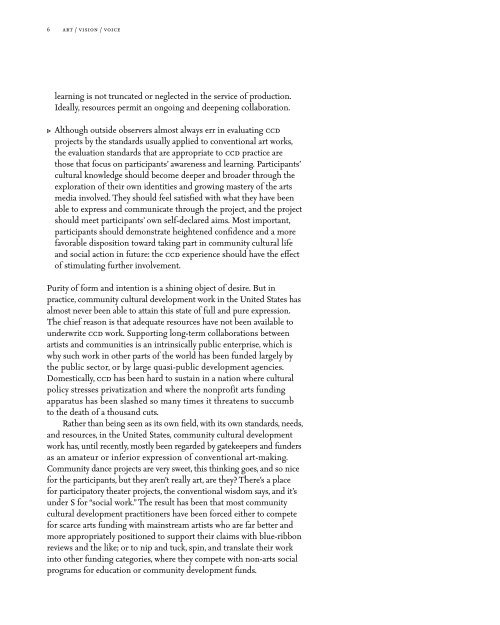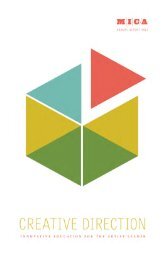art/vision/voice - Maryland Institute College of Art
art/vision/voice - Maryland Institute College of Art
art/vision/voice - Maryland Institute College of Art
You also want an ePaper? Increase the reach of your titles
YUMPU automatically turns print PDFs into web optimized ePapers that Google loves.
6 <strong>art</strong> / <strong>vision</strong> / <strong>voice</strong><br />
learning is not truncated or neglected in the service <strong>of</strong> production.<br />
Ideally, resources permit an ongoing and deepening collaboration.<br />
v Although outside observers almost always err in evaluating ccd<br />
projects by the standards usually applied to conventional <strong>art</strong> works,<br />
the evaluation standards that are appropriate to ccd practice are<br />
those that focus on p<strong>art</strong>icipants’ awareness and learning. P<strong>art</strong>icipants’<br />
cultural knowledge should become deeper and broader through the<br />
exploration <strong>of</strong> their own identities and growing mastery <strong>of</strong> the <strong>art</strong>s<br />
media involved. They should feel satisfied with what they have been<br />
able to express and communicate through the project, and the project<br />
should meet p<strong>art</strong>icipants’ own self-declared aims. Most important,<br />
p<strong>art</strong>icipants should demonstrate heightened confidence and a more<br />
favorable disposition toward taking p<strong>art</strong> in community cultural life<br />
and social action in future: the ccd experience should have the effect<br />
<strong>of</strong> stimulating further involvement.<br />
Purity <strong>of</strong> form and intention is a shining object <strong>of</strong> desire. But in<br />
practice, community cultural development work in the United States has<br />
almost never been able to attain this state <strong>of</strong> full and pure expression.<br />
The chief reason is that adequate resources have not been available to<br />
underwrite ccd work. Supporting long-term collaborations between<br />
<strong>art</strong>ists and communities is an intrinsically public enterprise, which is<br />
why such work in other p<strong>art</strong>s <strong>of</strong> the world has been funded largely by<br />
the public sector, or by large quasi-public development agencies.<br />
Domestically, ccd has been hard to sustain in a nation where cultural<br />
policy stresses privatization and where the nonpr<strong>of</strong>it <strong>art</strong>s funding<br />
apparatus has been slashed so many times it threatens to succumb<br />
to the death <strong>of</strong> a thousand cuts.<br />
Rather than being seen as its own field, with its own standards, needs,<br />
and resources, in the United States, community cultural development<br />
work has, until recently, mostly been regarded by gatekeepers and funders<br />
as an amateur or inferior expression <strong>of</strong> conventional <strong>art</strong>-making.<br />
Community dance projects are very sweet, this thinking goes, and so nice<br />
for the p<strong>art</strong>icipants, but they aren’t really <strong>art</strong>, are they? There’s a place<br />
for p<strong>art</strong>icipatory theater projects, the conventional wisdom says, and it’s<br />
under S for “social work.” The result has been that most community<br />
cultural development practitioners have been forced either to compete<br />
for scarce <strong>art</strong>s funding with mainstream <strong>art</strong>ists who are far better and<br />
more appropriately positioned to support their claims with blue-ribbon<br />
reviews and the like; or to nip and tuck, spin, and translate their work<br />
into other funding categories, where they compete with non-<strong>art</strong>s social<br />
programs for education or community development funds.
















